Key takeaways:
- Regular solar inspections are essential for optimal performance and longevity of solar systems on luxury yachts, preventing minor issues from escalating into major problems.
- Utilizing the right tools, like thermal imaging cameras and multimeters, enhances the effectiveness of inspections by uncovering hidden inefficiencies and ensuring accurate readings.
- Attention to detail, thorough documentation, and collaboration with crew members during inspections can lead to the discovery of critical issues and improve overall maintenance practices.
- Building trust and rapport with yacht owners encourages open discussions about vulnerabilities, fostering a more comprehensive and honest inspection process.
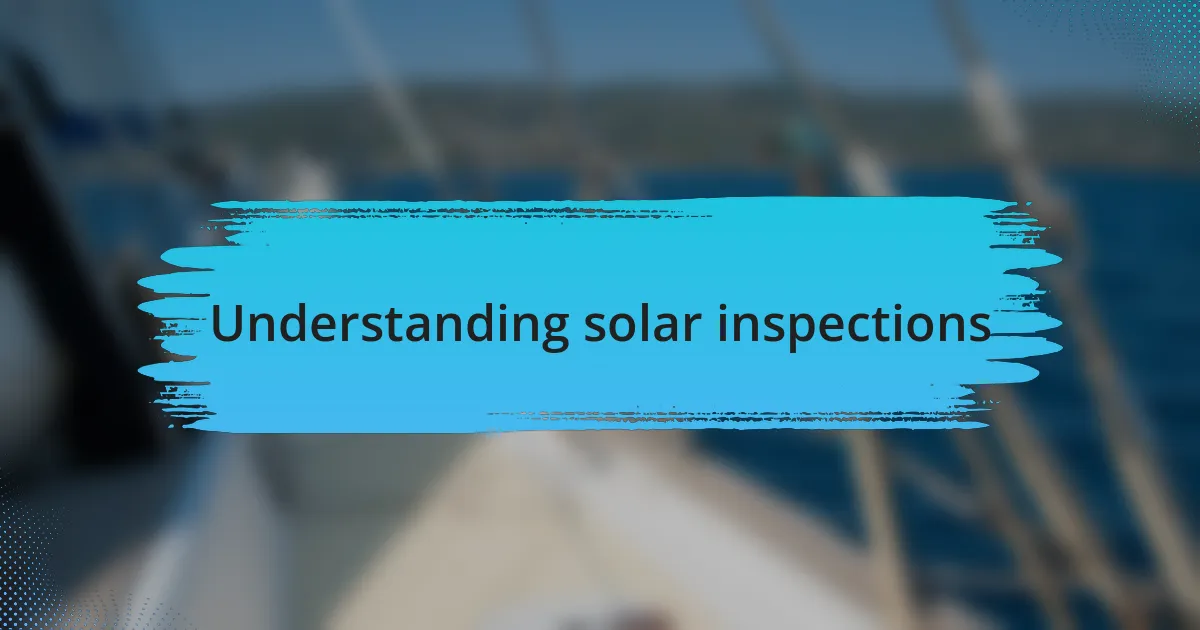
Understanding solar inspections
Solar inspections are crucial for ensuring that the solar energy systems on luxury yachts are functioning optimally. From personal experience, I’ve learned that overlooking a small issue during inspection can lead to significant performance drops, and trust me, the last thing you want is to be facing electrical problems while sailing in the open sea. Have you ever wondered how much energy those solar panels are actually producing?
During a recent solar inspection on my yacht, I discovered that a minor dirt buildup on one panel was reducing its efficiency. This little revelation made me appreciate how vital it is to keep your solar panels clean and unobstructed. It’s not just about having the technology; it’s about nurturing it to perform at its best. Have you ever felt that thrill of seeing your systems running at peak efficiency?
Another essential aspect of solar inspections is checking the wiring and connections. Poor connections can be a hidden risk, and I’ve had my fair share of electrical quirks due to neglecting this part. Engaging with professionals who really understand solar systems can provide peace of mind, ensuring that everything is in top condition. How often do you think about the importance of maintaining those connections? The answer can change your entire experience on the water.

Importance of solar inspections
Solar inspections play a pivotal role in maintaining the integrity of solar energy systems on luxury yachts. I vividly remember the tension I felt during one trip when I noticed fluctuating energy levels; a quick inspection revealed that a connection was on the verge of failure. Wouldn’t it have been frustrating to lose power while out at sea?
In my experience, regular inspections not only enhance efficiency but also extend the lifespan of solar panels. There was a time my yacht’s solar array sparked during a storm, which was mitigated by a recent inspection that reinforced my confidence. Isn’t it comforting to know that your investment is well protected?
Moreover, solar inspections help identify potential issues before they escalate into bigger problems. I’ll never forget the sinking feeling of hearing that unusual hum coming from the inverter, only to find out it was nothing serious thanks to proactive checks. The peace of mind I gained from that experience reminded me just how essential these inspections really are. Have you ever considered how these small yet significant steps contribute to overall safety and efficiency?
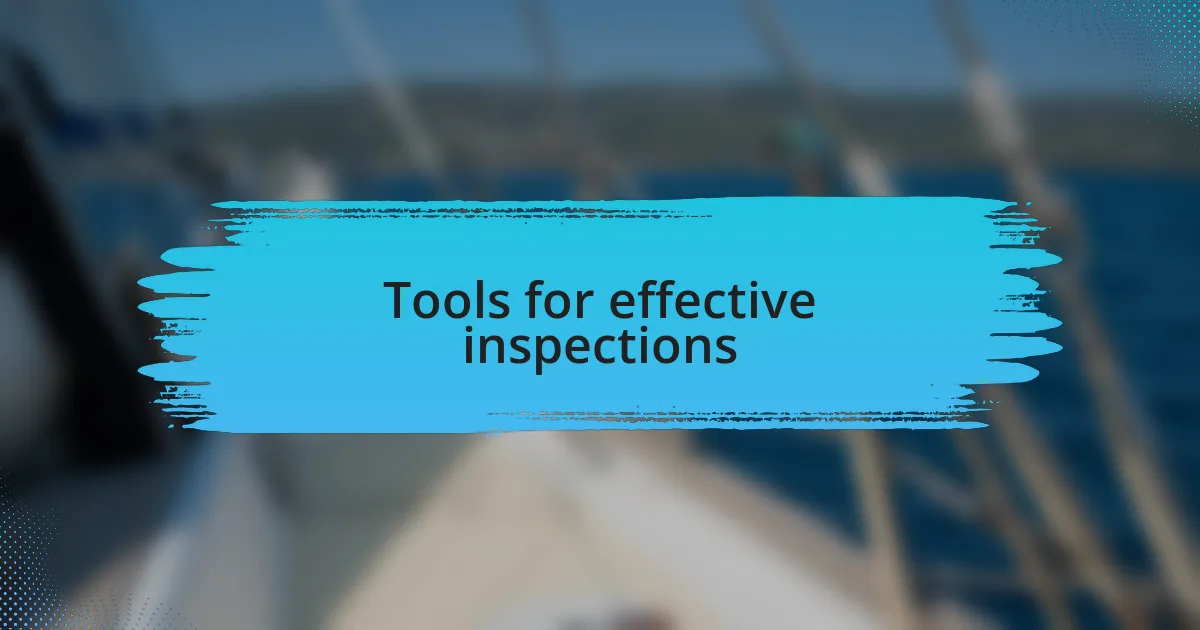
Tools for effective inspections
When it comes to effective solar inspections, having the right tools can make all the difference. I’ve found that a thermal imaging camera is invaluable; it allows me to identify hot spots on solar panels that would be invisible to the naked eye. The first time I used one, I was amazed at how quickly I spotted a malfunctioning cell that could have caused significant energy loss. Have you ever thought about how much efficiency a small hidden issue could cost you?
Multimeters are another essential tool in my inspection kit. They help me measure voltage and current directly from the panels and throughout the system. I remember one instance when a reading showed unexpected fluctuations; a quick adjustment to the wiring resolved it before we even set sail. How often do we overlook the importance of accurate readings during our checks?
Finally, I can’t stress enough the value of a reliable cleaning kit. Maintaining clean panels is crucial for optimal energy conversion, especially after a long journey at sea, where salt and debris accumulate. The first time I cleaned my panels before an important trip, I was pleasantly surprised by the boost in energy efficiency. Isn’t it fascinating how simple maintenance can lead to significant improvements?
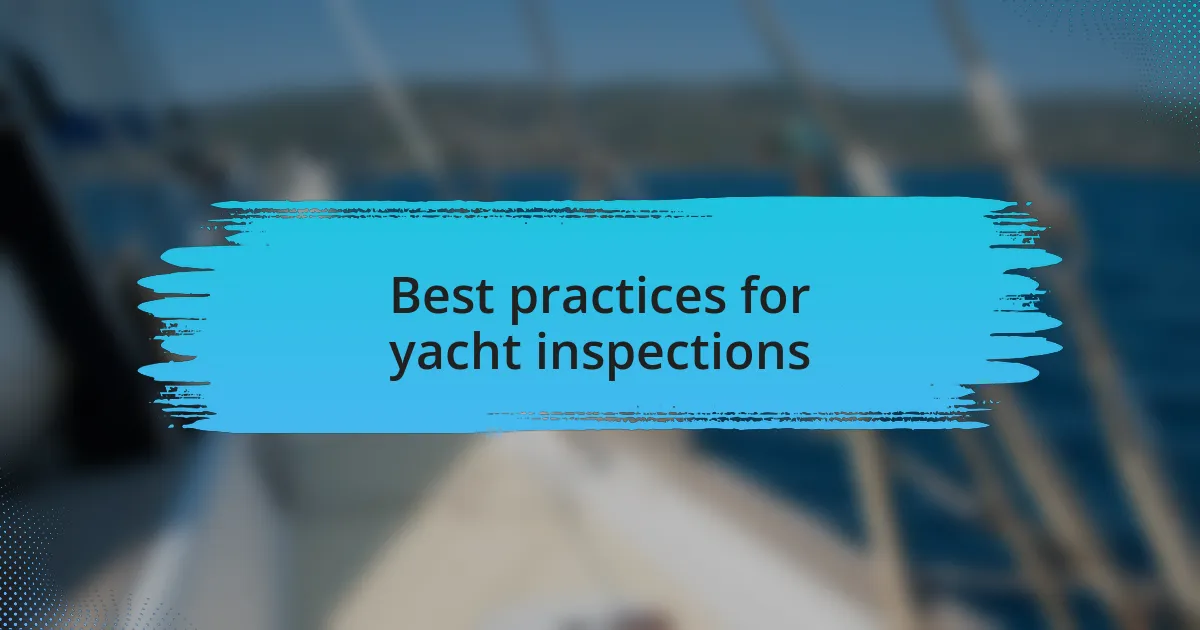
Best practices for yacht inspections
Attention to detail is paramount during yacht inspections. I’ve learned that developing a systematic approach not only streamlines the process but also uncovers hidden issues. Once, I meticulously documented every aspect while inspecting a client’s yacht, and it revealed slight corrosion on a crucial fitting that would have gone unnoticed otherwise. How often do we assume everything is fine without doing a thorough check?
Another vital practice is enlisting the help of a second set of eyes. I remember a time when a fellow inspector accompanied me, and together we caught misaligned rigging that could have compromised safety. Having someone else on board not only helps spot details but also provides an opportunity for valuable discussions on best practices. Aren’t conversations like these what enrich our knowledge and skills?
Lastly, I can’t emphasize the importance of following up on repairs promptly. After addressing an issue, I make it a point to revisit the yacht after some time to ensure everything remains in top condition. During one such follow-up, I discovered a minor leak had returned, allowing me to address it before it became a major problem. Isn’t proactive maintenance the key to prolonging the life of our beloved vessels?
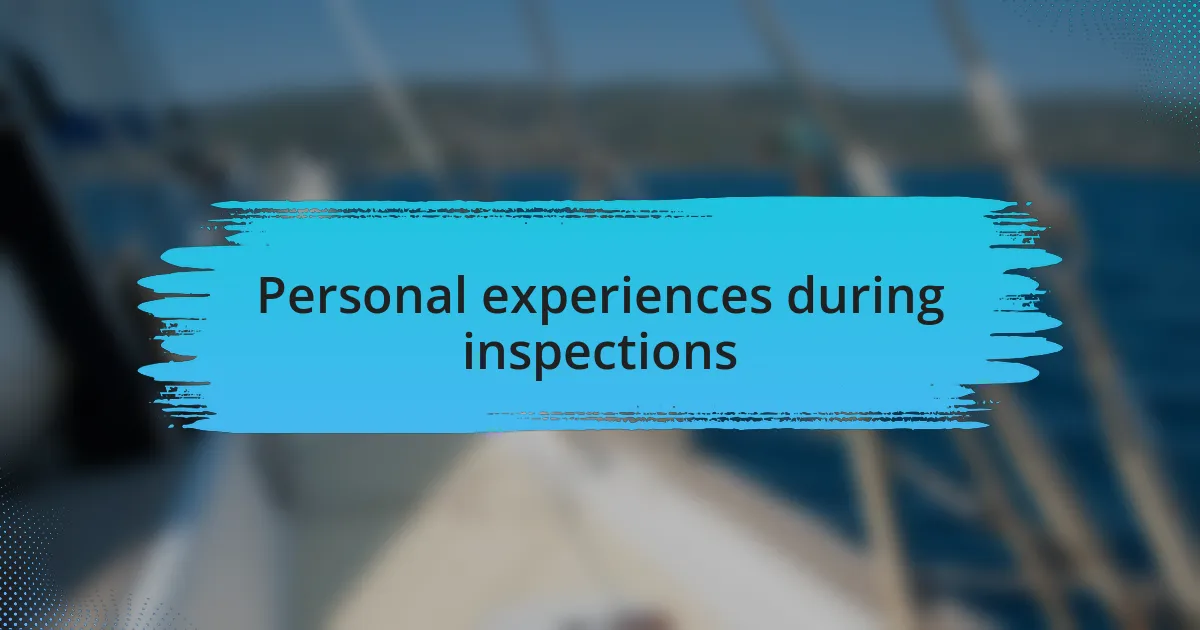
Personal experiences during inspections
During my inspections, I often find myself reflecting on the unexpected challenges that arise. One particular instance stands out: while examining a stunning yacht in an upscale marina, I stumbled upon a glitch in the navigation system. The owner had dismissed it as a minor annoyance, but I instinctively knew it warranted deeper investigation. My heart raced as I realized how crucial that malfunction could be during a critical moment at sea. Have you ever experienced that rush when uncovering something significant? It’s a reminder of why I love what I do.
Another memorable experience involved an inspection that took place right before a major regatta. The anticipation in the air was palpable as I assessed a high-performance racing yacht. Amidst the tension, I discovered that the keel bolts were showing signs of fatigue. I vividly remember the owner’s face when I pointed it out; it was a mix of relief and gratitude. It’s moments like these that reinforce the importance of vigilance in our line of work. How often do we overlook issues because of excitement or stress?
Conversing with experienced crew members during inspections also sheds light on overlooked details. One time, while discussing maintenance routines with a captain, I learned about the unique ways they adapted to local conditions. This exchange not only enhanced my understanding but created a bond that enriched the inspection process. That day, I left with more than just technical insights—I gained a deeper appreciation for the passion and commitment that fuels the luxury yachting community. Isn’t it fascinating how these interactions shape our professional journeys?
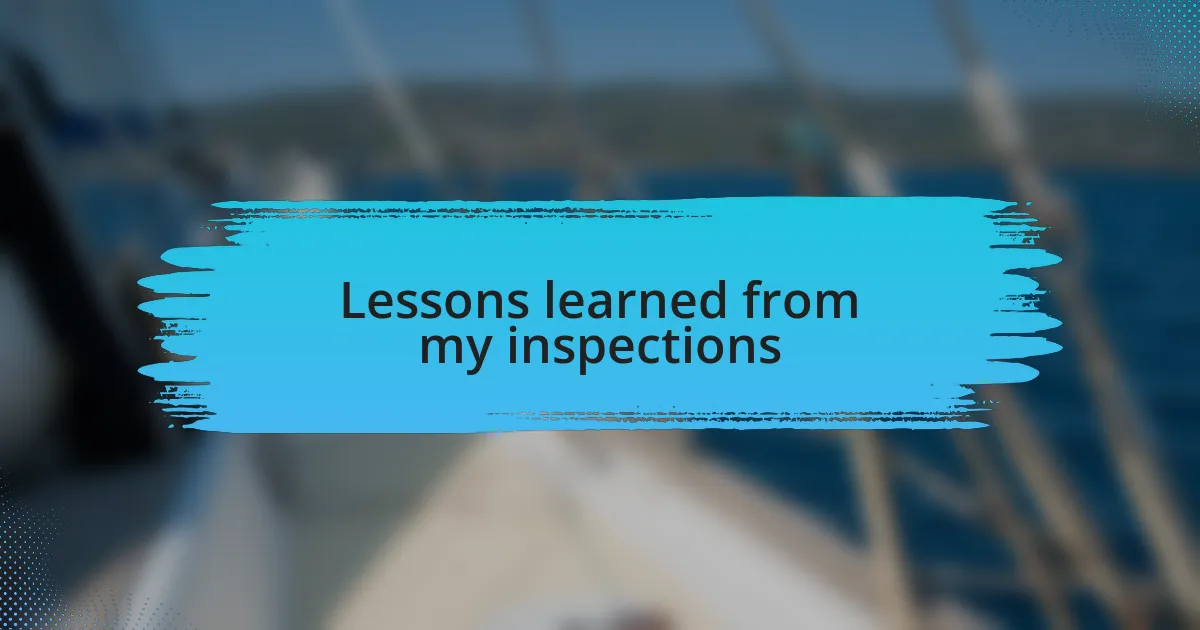
Lessons learned from my inspections
During my inspections, I’ve learned that every yacht has its own story woven into the fabric of its design and maintenance. On one occasion, I found myself crouched in the engine room of a classic motor yacht, surrounded by the rich scent of polished wood and metal. As I inspected the engine’s components, I realized the owner had custom solutions for several engineering challenges. It was a testament to how pride and personalization can elevate a vessel’s functionality. Have you ever stopped to appreciate the love poured into such details?
One particularly insightful lesson came during an inspection of a sailing yacht that had recently undergone extensive renovations. While noting the upgrades, I observed how the crew’s enthusiasm echoed through every corner of the boat. Yet, in a moment of quiet, I noticed that the bilge system hadn’t been updated alongside the glamorous new features. I couldn’t help but wonder: how many beautiful exteriors mask internal inefficiencies? That insight taught me the importance of assessing not just what the eye can see, but what lies beneath.
I’ve also discovered that trust plays a pivotal role in the inspection process. There was an instance where I was inspecting a yacht that a friend owned. He had faith in my judgment, which allowed for open discussions about vulnerabilities he hadn’t considered. This experience reinforced my belief that establishing a rapport fosters a more thorough and honest inspection. Have you ever felt that thrill of mutual respect transforming a professional encounter? It’s moments like these that remind me of the profound connections we build in this industry.
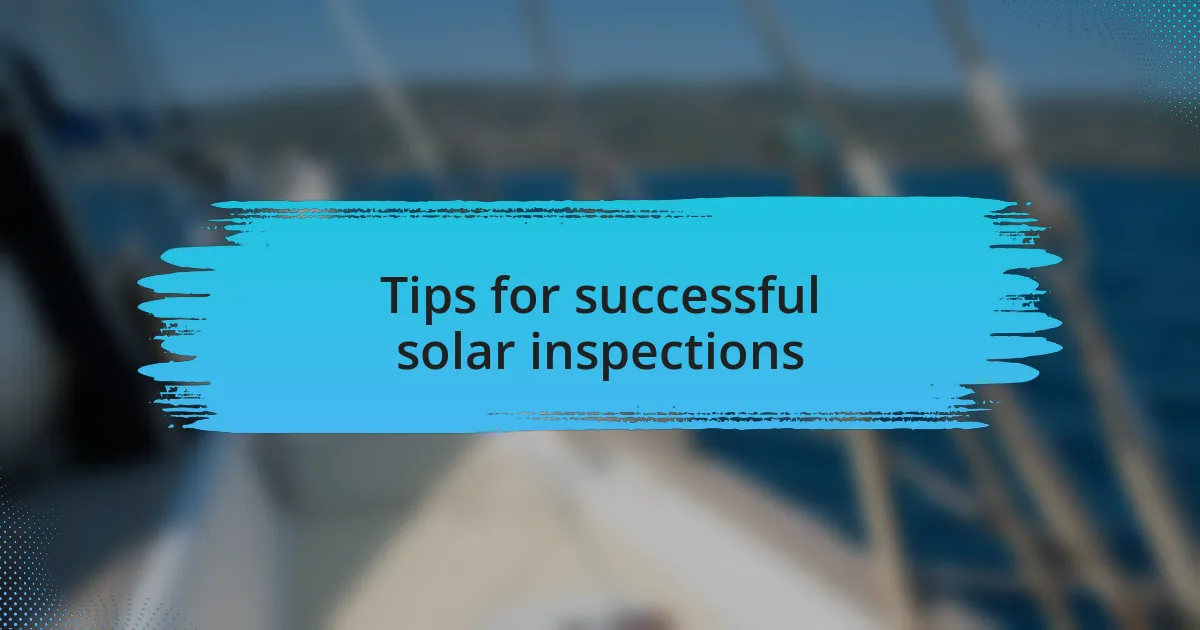
Tips for successful solar inspections
When preparing for a solar inspection, I’ve found that thorough scheduling is key. One time, I scheduled an inspection during a busy maintenance period, and it proved to be chaotic. The myriad distractions not only affected my focus but also made it difficult to thoroughly assess the solar components. Isn’t it fascinating how timing can impact the quality of our observations?
Another invaluable tip is to come equipped with the right tools. I once made the mistake of underestimating the need for advanced diagnostic equipment. On that inspection, I had to rely solely on visual assessments, which left me feeling uneasy about potential issues I may have overlooked. It’s imperative to think ahead and ensure that you have everything you need to assess the solar systems comprehensively. Have you ever been caught in a situation like that, wishing for just one more tool?
Lastly, engaging with the crew before the inspection can make a world of difference. I remember chatting with the crew on a larger yacht, and they shared insights about the vessel’s energy usage patterns that weren’t documented anywhere. This dialogue not only enriched my inspection but also illustrated the importance of collaboration. How often do we overlook the knowledge right on deck? The crew often knows their yacht’s systems better than anyone else, and tapping into that wisdom can yield richer insights.